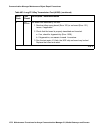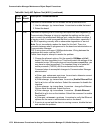
Communication Manager Maintenance-Object Repair Procedures
1384 Maintenance Procedures for Avaya Communication Manager 3.0, Media Gateways and Servers
b. Physically remove the circuit pack from the slot.
b. Error Type 18: The IP Media Resource was busied out by a busyout board location.
1. Release the circuit pack (release board location).
c. Error Type 23: The IP Media Resource is not completely administered. To be fully
administered, an IP Media Resource must:
● Have an entry in the circuit plan (change circuit-pack)
● Have an administered IP address (change node-names ip)
● Be enabled (change ip-interface)
● Be physically inserted into the correct slot.
An IP Media Resource differs from most circuit packs in that inserting the circuit pack into
the switch is not enough to make the board usable. It must also be administered.
d. Error Type 125: The wrong circuit pack is inserted in the slot where this circuit pack is
logically administered. Do one of the following:
● Remove the wrong circuit pack and insert the logically administered circuit pack.
● Re-administer this slot to match the circuit pack inserted (change circuit-pack).
e. Error Type 257: failure of the Control Channel test (#52). See Control Channel
Loop-around Test (#52) on page 1362 for details.
f. Error Type 513: transient hardware device problems on the board. They include an
external RAM failure, internal RAM failure, ROM checksum failure, message corruption,
and program logic inconsistency. There are no associated tests for these inline errors; if
they continue to happen, an alarm will occur.
g. Error Type 769: failed attempts to verify IP network connectivity between a specified IP
Media Resource and other IP Media Resources in the system. See Test #1505 for Short IP
2-way transmission test failures and Test #1506 IP long 2-way transmission test failures.
h. Error Type 1281: certain firmware modules or components on the board failed to initialize
properly. This test is only run at board insertion. When the board is first inserted this test is
run to verify that the embedded software (firmware) applications on the board are working
properly. If the test fails, it is immediately run a second time. If the test fails a second time an
alarm is raised. See Board StatusTest (#1402)
on page 1392 for more information.
i. Error Type 1538: hyperactivity on the board. The circuit pack is sending too many
messages to switch software. The circuit pack will be taken out of service. See Error Type
3999.
j. Error Type 1793: no electrical signal is detected on the Ethernet cable. The Ethernet cable
is unplugged or there is a problem with a connection to the network interface.
k. Error Type 2049: Packet Count Query, indicates a problem with the packet bus.
l. Error Type 2305: IP address inconsistency between switch software and the IP Media
Resource. If this error occurs, an attempt will be made to download the IP address again. If
the board still refuses the IP address, the board will be reset. See associated test #1371.


















